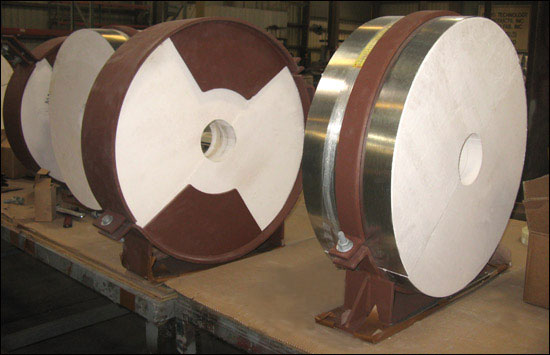 CPS Systems are defined in Chapter 1 Par 100.2, as systems on which condition assessments are to be conducted. This includes the following systems as a minimum. NPS 4 and larger main steam, hot reheat steam, cold reheat steam, and boiler feedwater piping. NPS 4 and larger systems that operate above 750°E (400°C or above 1,025 psi (7,100 kPa) Other systems may be included as CPS by an Operating Company, based on their judgment. Appendix V of the code is titled 'Recommended Practice for Operation, Maintenance, and Modification of Power Piping Systems'. This addendum is non-mandatory; however many Power Industry operating companies' insurance carriers are now invoking Appendix V with increasing frequency, and this is affecting conditions of their agreements with the operating companies. Piping Technology and Products Inc. (PT&P) has for some time been performing surveys and assessments in accordance with part H of Par. 140, that requires hot and cold walk-down readings and assessment of pipe supports, operated within the creep regime of the pipe. These assessments are helpful in identifying, sagging lines, deformation of supports, and damage caused by upset conditions, and/or incidents, attributable to operational malfunctions, dynamic/thermal or hydraulic events. PT&P has been performing this service for many power generation companies. Preparation of documentation, retrieval and compilation of files for a CPS assessment, has just been completed for a major U.S power generation company. Ten large power plants were involved, and the original predominantly high-energy pipe support drawings, all engineered and designed by PT&P, were retrieved from PT&P archives dating back ten years. Please feel free to contact us at david.baker@pipingtech.com and we will be happy to answer any of your technical questions about our survey capabilities, as well as any other engineering or field services that your organization may need.
CPS Systems are defined in Chapter 1 Par 100.2, as systems on which condition assessments are to be conducted. This includes the following systems as a minimum. NPS 4 and larger main steam, hot reheat steam, cold reheat steam, and boiler feedwater piping. NPS 4 and larger systems that operate above 750°E (400°C or above 1,025 psi (7,100 kPa) Other systems may be included as CPS by an Operating Company, based on their judgment. Appendix V of the code is titled 'Recommended Practice for Operation, Maintenance, and Modification of Power Piping Systems'. This addendum is non-mandatory; however many Power Industry operating companies' insurance carriers are now invoking Appendix V with increasing frequency, and this is affecting conditions of their agreements with the operating companies. Piping Technology and Products Inc. (PT&P) has for some time been performing surveys and assessments in accordance with part H of Par. 140, that requires hot and cold walk-down readings and assessment of pipe supports, operated within the creep regime of the pipe. These assessments are helpful in identifying, sagging lines, deformation of supports, and damage caused by upset conditions, and/or incidents, attributable to operational malfunctions, dynamic/thermal or hydraulic events. PT&P has been performing this service for many power generation companies. Preparation of documentation, retrieval and compilation of files for a CPS assessment, has just been completed for a major U.S power generation company. Ten large power plants were involved, and the original predominantly high-energy pipe support drawings, all engineered and designed by PT&P, were retrieved from PT&P archives dating back ten years. Please feel free to contact us at david.baker@pipingtech.com and we will be happy to answer any of your technical questions about our survey capabilities, as well as any other engineering or field services that your organization may need.The Pipe Support Blog
ASME Defines New Inspection Criteria for High Energy Pipelines
 CPS Systems are defined in Chapter 1 Par 100.2, as systems on which condition assessments are to be conducted. This includes the following systems as a minimum. NPS 4 and larger main steam, hot reheat steam, cold reheat steam, and boiler feedwater piping. NPS 4 and larger systems that operate above 750°E (400°C or above 1,025 psi (7,100 kPa) Other systems may be included as CPS by an Operating Company, based on their judgment. Appendix V of the code is titled 'Recommended Practice for Operation, Maintenance, and Modification of Power Piping Systems'. This addendum is non-mandatory; however many Power Industry operating companies' insurance carriers are now invoking Appendix V with increasing frequency, and this is affecting conditions of their agreements with the operating companies. Piping Technology and Products Inc. (PT&P) has for some time been performing surveys and assessments in accordance with part H of Par. 140, that requires hot and cold walk-down readings and assessment of pipe supports, operated within the creep regime of the pipe. These assessments are helpful in identifying, sagging lines, deformation of supports, and damage caused by upset conditions, and/or incidents, attributable to operational malfunctions, dynamic/thermal or hydraulic events. PT&P has been performing this service for many power generation companies. Preparation of documentation, retrieval and compilation of files for a CPS assessment, has just been completed for a major U.S power generation company. Ten large power plants were involved, and the original predominantly high-energy pipe support drawings, all engineered and designed by PT&P, were retrieved from PT&P archives dating back ten years. Please feel free to contact us at david.baker@pipingtech.com and we will be happy to answer any of your technical questions about our survey capabilities, as well as any other engineering or field services that your organization may need.
CPS Systems are defined in Chapter 1 Par 100.2, as systems on which condition assessments are to be conducted. This includes the following systems as a minimum. NPS 4 and larger main steam, hot reheat steam, cold reheat steam, and boiler feedwater piping. NPS 4 and larger systems that operate above 750°E (400°C or above 1,025 psi (7,100 kPa) Other systems may be included as CPS by an Operating Company, based on their judgment. Appendix V of the code is titled 'Recommended Practice for Operation, Maintenance, and Modification of Power Piping Systems'. This addendum is non-mandatory; however many Power Industry operating companies' insurance carriers are now invoking Appendix V with increasing frequency, and this is affecting conditions of their agreements with the operating companies. Piping Technology and Products Inc. (PT&P) has for some time been performing surveys and assessments in accordance with part H of Par. 140, that requires hot and cold walk-down readings and assessment of pipe supports, operated within the creep regime of the pipe. These assessments are helpful in identifying, sagging lines, deformation of supports, and damage caused by upset conditions, and/or incidents, attributable to operational malfunctions, dynamic/thermal or hydraulic events. PT&P has been performing this service for many power generation companies. Preparation of documentation, retrieval and compilation of files for a CPS assessment, has just been completed for a major U.S power generation company. Ten large power plants were involved, and the original predominantly high-energy pipe support drawings, all engineered and designed by PT&P, were retrieved from PT&P archives dating back ten years. Please feel free to contact us at david.baker@pipingtech.com and we will be happy to answer any of your technical questions about our survey capabilities, as well as any other engineering or field services that your organization may need.High Temperature Pipe Supports for a Carbon Manufacturing Plant
These high temperature pipe supports have a 25" outside diameter, and were custom designed for a granular activated carbon manufacturing plant in Hawaii. They are fabricated from A-36 carbon steel with 10" thick high density calcium silicate insulation. The hot shoes were designed for a 4" diameter pipe-line, temperatures up to 1,800°F and an operating load of 1,000 lb. Standard Q.C. and dimensional tests were performed prior to an expedited shipment.
Do you require hot shoes on an upcoming project? Get pricing today!
Do you have a hydraulic snubber would you like inspect, but don't know where to begin? Visit our visual media section and learn How To Inspect a Hydraulic Snubber. This video will go over the four main steps when inspecting a hydraulic snubber. If you have any questions, feel free to call us at 713-731-0030 or email us at info@pipingtech.com.
Tags: Hydraulic Snubber, Snubber
These 200 U-Type constant spring supports were modified to increase their installed height by adding a secondary plate and angles, which will be welded to the structural beam. The constants range in size from 25" to 27" in height, 52" to 67" in length, and 25" in width. Their load capacities range from 10,300 lb. to 13,000 lb. with vertical movement ranging from 3" to 4-1/2". All constants were fabricated from A-36 carbon steel, and went through standard load and travel testing per MSS Standards prior to shipment. Do you have a similar application that requires upthrust constants? Get pricing today!
This Webinar is over... visit www.pipingtech.com/webinar
Subject: Constant Spring Supports Design and Application Webinar ** Webinar is worth 1 PDH Credit for TX Professional Engineers
Date: Thursday, January 19, 2012
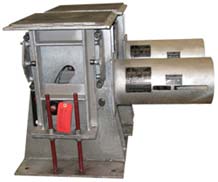 This Webinar will focus on the different types of constant spring supports. Learn about the special features available, in addition to the design of a constant support. View how the different cam/coil configurations produce a unique response to an applied load. Discover the step by step process used to size a spring for your application. Learn about the different attachments, testing, and installation and maintenance procedures. View examples of failed supports provided by our Field Service Division and learn why they failed and how to prevent it. Gain knowledge of the valuable tips used when deciding to adjust or replace a constant spring support, as well as shutdown and isolation procedures.
This Webinar will focus on the different types of constant spring supports. Learn about the special features available, in addition to the design of a constant support. View how the different cam/coil configurations produce a unique response to an applied load. Discover the step by step process used to size a spring for your application. Learn about the different attachments, testing, and installation and maintenance procedures. View examples of failed supports provided by our Field Service Division and learn why they failed and how to prevent it. Gain knowledge of the valuable tips used when deciding to adjust or replace a constant spring support, as well as shutdown and isolation procedures.The featured presenter, Jerry Godina has over 13 years experience as a pipe support designer and manages PT&P's engineer training development program. He also inspects existing supports, consults on site remediation projects and oversees installation on a regular basis.
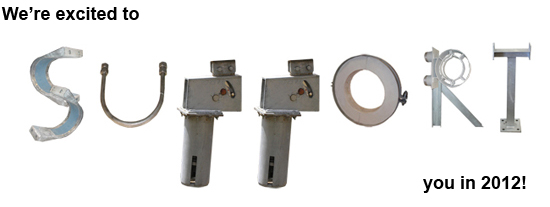
Happy New Years from the PT&P Pipe Support Team
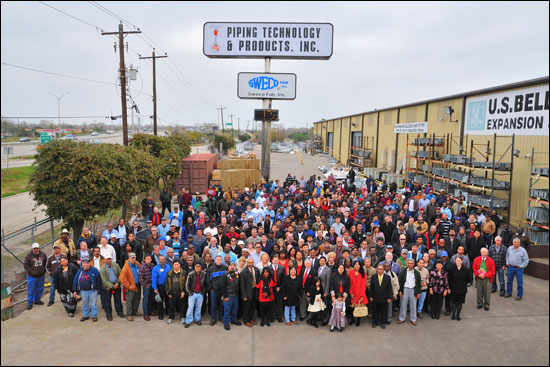
Tags: Piping Technology News
These PTP-1 F-Type variable spring assemblies fabricated from A-36 carbon steel, were custom designed to accommodate a height of 11-11/16" while keeping the same spring rate. The F-Type variable is used to support the pipe from below and are typically mounted to concrete pads via anchor bolts or welded to structural steel. The variables are designed for loads up to 6,500 lb. and a total upward travel of 5/16".
Want to learn more about variable springs? Check out a recording of a past live webinar.
Tags: Variable Spring Assemblies, Pipe Supports, Engineered Spring Supports
Subject: Variable Spring Support Design, Size Selection, Installation & Maintenance ** Webinar is worth 1 PDH Credit for TX Professional Engineers
Date: Thursday, January 5, 2012

This Webinar will focus on the different types of variable spring supports and big ton variable spring supports. Learn about the special features available, in addition to the design of a variable support. View how the different coil configurations produce a unique response to an applied load and see how a spring assembly is loaded. Discover the basic steps in selecting a hanger design and the step by step process used to size a spring for your application.
Learn about the different attachments, testing, and installation and maintenance procedures. View examples of failed supports provided by our Field Service Division and learn why they failed and how to prevent it. Gain knowledge of the valuable tips used when deciding to replace or re-calibrate a variable spring support, as well as adjustments, shutdown and isolation procedures.
The featured presenter, Jerry Godina has over 13 years experience as a pipe support designer and manages PT&P's engineer training development program. He also inspects existing supports, consults on site remediation projects and oversees installation on a regular basis.
Tags: Variable Spring Assemblies, Engineered Spring Supports
48" Diameter Stainless Steel Glycol Makeup Tank Fabricated by Sweco
This Glycol Makeup Tank is fabricated entirely from ASTM A240-304 stainless steel and is rated for 0 psig at 150°F. The tank has a 1,000 gallon capacity and measures 48" I.D. x 10'-8" seam-to-seam. The stand pictured behind is also fabricated from stainless steel and measures 11' high. The customer ordered six additional units and all the Makeup Tanks underwent leak testing prior to shipment.
Want to learn more about variable springs? Check out a recording of a past live webinar.
Take an Inside Look at Our Past 35 Years of Pipe Support History
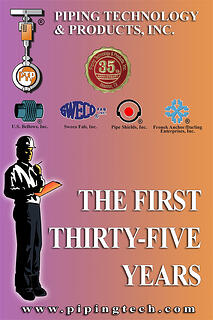
Tags: history, Piping Technology News, Piping Technology History

